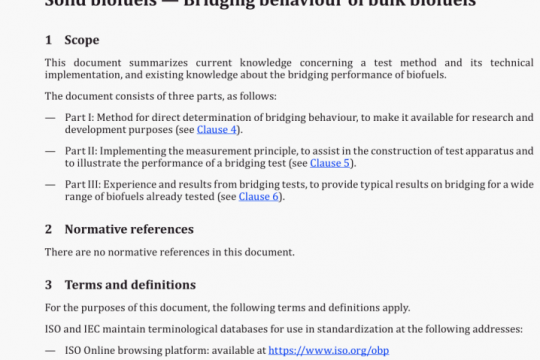ISO 22392 pdf free download
ISO 22392-2020 pdf free download.Security and resilience一Community resilience – Guidelines for conducting peer reviews.
These elements are the five analysis systems, which are used in 55.1 to review the performance of each analysis area.
4.5 Agree the high-level time line for the peer review
To enable initial planning, the host should agree an anticipated timeline for the delivery of the peer review, including:
— the official start date of the peer review period;
— when the review visit should take place;
— the delivery date of the consolidated report from the reviewers (see 5.9).
A detailed timeline should be developed in the delivery phase of the peer review, see Annex A.
4.6 Decide whether a self-assessment will be completed before the peer review
The host should consider whether they will complete a self-assessment as a preparation for the peer review. Options for a self-assessment include a document review (e.g. of risk register, strategy, plans). internal dialogues (e.g. discussions between staff and interested parties), and self-evaluation of current performance and costs.
A self-assessment takes time and effort, hut its potential benefits include:
— enabling the host to gather evidence of activities in a structured way;
— enabling the host to establish its own view of its activities;
— providing benchmarks for the peer review;
— informing the selection of benefits and measures of the peer review (see 43);
— assisting in selecting analysis areas that would be most beneficial to be peer reviewed;
— providing additional information to reviewers as part of background information.
An option for self-assessment is the UNISDR Preliminary Disaster Resilience Scorecard for Citiesll.
4.7 Consider the cost/benefit of hosting the peer review
The host should consider the cost of conducting the peer review (e.g. travel costs, meeting costs, administration costs, opportunity costs). As the initiator of the review and the major beneficiary, the host should expect to pay all costs associated with the review unless another source of funding is available.
Using information on the costs and the benefits (see 43) of the review, the host should assess if there is a sufficient return on investment from conducting the peer review. The assessment should be used to:
— judge the case for conducting the peer review;
— judge the case for the scale of the peer review;
— calibrate the breadth and depth of the peer review to ensure a sufficient return on investment.
4.8 Identify parties who are interested in the peer review
The host should identify organizations and individuals, groups and partners with an interest in the process or outcome of the peer review to consider if they should be involved in the design and delivery of the review. The host should:
— identify parties with an interest in enhancing performance (e.g. elected officials, those indirectly or directly affected by the review, those wishing to learn from the review, citizens and their representatives);
— consider the implications of involving or not involving interested parties in the peer review process;
— decide if and how interested parties should be involved in the peer review process;
— review who are the important interested parties once the analysis areas have been selected (see 4,9).
Examples of interested party groups include government officials, responders, private sector staff,
academics, citizens, citizen representatives and elected officials.
4.9 Select the analysis areas to be peer reviewed
With the influential interested parties (see 4.) and, potentially, the reviewers (see 4J..3) and, if conducted, using the results of the self-assessment (see 4f), the host should select the analysis areas to be reviewed according to its preferences and the agreed objectives (see 4,4). See Annex B for potential analysis areas. As each analysis area is estimated to take one day of a review visit (plus activities before the visit), the host should decide on the number, depth and specificity of the analysis areas to be reviewed.
Risk management and assessment of risk are two important analysis areas that should be included in every peer review to provide sufficient background information to reviewers. If these two analysis areas are not included, then information of sufficient detail on these topics should be provided to reviewers.
The host should select the analysis areas to be reviewed. Descriptions of the options are provided in Annex B. The selection of analysis areas will depend on the duration of the review visit. Some analysis areas are of a strategic nature while others are operational.
Not every peer review should cover all the analysis areas in Annex B. In addition to those in Annex B the host should consider if there are any other analysis areas that should be reviewed. The design of those should follow those outlined in Annex B.
4.10 Appoint an organization to coordinate the peer review
Once the interested parties (see 4,8), benefits (see 4.3) and objectives (see 4,4) have been identified, the host should appoint an organization to coordinate the peer review, including to:
— project-manage the delivery of the peer review to achieve the objectives of the review and support the benefit owners;
— conduct the administrative arrangements of the peer review for the host and reviewers.ISO 22392 pdf download.




